
The Retrogaming Times
- The Bimonthly Retrogaming Hobbyist
Newsletter -

The Retrogaming Times
- The Bimonthly Retrogaming Hobbyist
Newsletter -
| The Retrogaming Times |
|
PAGE ONE - PAGE TWO - |
|
There was a time when I attended many classic game conventions. From the first one that I ever heard of, Electronicon to the Phillyclassic to the local CCAG, I went to many shows. What they all had in common was they were geared towards classic games, the games from the late 1970's to the early 1980's. The golden age of console games as I have heard it described as. You would go and see endless rows of Atari 2600, Intellivision, Colecovision and other games. If you looked hard enough, you could find some more obscure systems like the Odyssey 2, the Vectrex and the Bally Astrocade. There was also a good selection of classic computers like the Commodore 64, Apple II, Atari 400/800 and TI 99. While there would be some newer systems like Nintendo, Sega and Sony, there were a vast minority.
Well, I heard from my brother that the CCAG (Classic Console and Arcade Game) was still going on and drew a huge crowd. I had not gone to one in about a dozen years and thought it would be interesting to see what the classic game market was like and see some old friends.
After seeing on the website the long lines to get in, I decided to go later. Since I was not there to buy games, I did not need to be at the front of the line, looking for great deals. I brought one of my son's, Joshua, who is going into his senior year at Shawnee State University, getting a degree in video game programming. He has a decent collection of Nintendo games, going back to the Super NES and as modern as the Nintendo Switch. He probably has just about every Mario, Sonic, Zelda, Yoshi and Wario game made from that era. I figured a show like this would be a good place for him to find some obscure games and maybe a few that he has not bought. But with ebay and Amazon, you can find pretty much any game you ever wanted.
We arrive around 2:00 PM to a crowded parking lot. The show started at 12:00 PM, so I figured the long lines should be gone. I was right as we walked right in. We were greeted by a sea of people, my guess is somewhere around 200 people shopping as well as vendors. There were rows and rows of tables set up with all kinds of games for sale.
It didn't take long to see how much different the show was from the ones I attended a decade ago. Nintendo is now king of the show. Almost everyone had tons of Nintendo, SNES, N64 and more recent games. And they were going for some crazy prices. Common games like Mario 64 were fetching $30.00 or more for a loose copy. I was stunned. I heard that classic Nintendo games were getting good money but I did not expect this. And the Atari 2600 games were going dirt cheap. I saw multiple boxes full of Atari games for a $1.00 each for the common games. The same prices or lower than what we were selling them for back in day. It made me laugh as I remember seeing an episode of Storage Wars where they found a box of loose Atari 2600 games and said they were worth $10.00 each. I laughed at how inaccurate it was, but little did I know how totally inaccurate it was. Even taking in to account for California's higher cost of living, it was still over exaggerated.
As I looked around, I did see a few familiar faces. I was able to talk with Mike Gedeon from Video Game Connection, Adam Harvey who had some amazing original Atari artwork and Alan Hewston who was a long time contributor to Retrogaming Times and took over when I stopped it and ran it as Retrogaming Times Monthly. It was nice to see them after so many years. We talked about the old shows and how things have changed. It was nice to talk about the old times for a bit. While part of me missed the old days of selling at shows, looking to fill holes in your collection and hoping someone would sell you some great games, I knew it was something that was in my past. I had to sell my personal collection years ago to pay for attorney fees when I was battling the school district to get appropriate schooling for my oldest son, Alex, who has autism. While it was painful to sell off the hundreds of games I had in my collection as well as large collection of tabletop and handheld systems, memorabilia and more, it was worth it, as we would not have our son living with us now if we did not get the help he needed.
At the end of the day, I bought a book, Supercade and a few Disney Infinity figures that were very cheap. My son found a few games, but I think he was overwhelmed by the sheer amount of stuff. He almost bought a Famicom just for the novelty of it, but hesitated and someone else bought it. Overall, it was a fun time but my trip down memory lane was not what I expected. I guess a part of me was looking for small community that was at the original shows. Now it was much more commercial. I couldn't tell you if there were deals or not as I have been out of it so long, I have no clue what stuff sells for. But it was sorta sad to see how little the classic games went for.
As I returned from my trip down memory lane, I was greeted a few days later by an email that Retrogaming Times is still going and it was getting ready to celebrate its 20th anniversary. I did not realize this. I knew the website hit 20 years old this year (and looks it), but I did not realize the newsletter was also 20 years. I also thought the newsletter finally died off a few years back. Like the mythical phoenix, it keeps rising up from the ashes.
I can still remember the reasons I first came up with the newsletter. It was after attending the Electronicon and seeing how different people were contributing to the hobby, whether it be a rarity guide, homebrew games or multicarts, that I wanted to be a part of it. Since I do not have programming skills, I decided to do a newsletter. There were no classic game newsletters online at the time and I figured it would be a way to give something back and give other gamers a voice. Little did I know that 20 years later it would still be going strong. I am glad that I was able to start a newsletter that gave so many contributors over the years a place to talk about their favorite games and memories. I hope it goes for another 20 years!
- Tom Zjaba (I still have the same email
address as I did back in the newsletter days - tomheroes@aol.com.
If any of the contributors from the past want to say hello, please send
an email. I would love to hear from some of my old friends that I
have lost contact with over the years.)
|
The Reality of the Atari 2600
The Atari 2600 (or VCS, as it was originally known) was designed at a time when both RAM and ROM were expensive bits of technology. In order to keep costs low, and given that the original life-span of the 2600 was supposed to be only a couple of years, the system was designed with only 128 bytes for RAM with the larger memory allotted to the cartridges that would contain the games. These cartridges, though, were meant to use no more than 4 KB of ROM (with many of the early games only using 2 KB as this would save on cost). These limitations, the low RAM in particular, made the job of the programmers harder when it came to developing games for the 2600 as the system could only handle so many variables at a time. With time programmers learned that there were tricks that could be done with their code that would enhance performance of the console but something that would make those tricks work better was having additional RAM. But how could this issue of RAM be addressed with a console like the 2600 when its available RAM was fixed?
Here Comes Arcadia / Starpath
In 1982 a company called Arcadia Corporation decided they would create a device that would address the limitations in RAM inherent in the 2600. They did so by engineering a special cartridge for the console that would increase the system's ram by 2900%! That's from the measly 128 bytes to 6,272 bytes (6 KB). This special cartridge was aptly called the Supercharger and it was larger than the typical game cartridge. The Supercharger has an elongated form that starts off with a standard opening as seen in other 2600 cartridges but it widens and ends with a handle. At the same end, it has a cable that can be connected to an audio tape player. This was another key feature of the system as it allowed for games programmed for the Supercharger to come in audio tapes rather than cartridges. This allowed for games that were both cheaper but better than what had been done up to this time with the 2600.
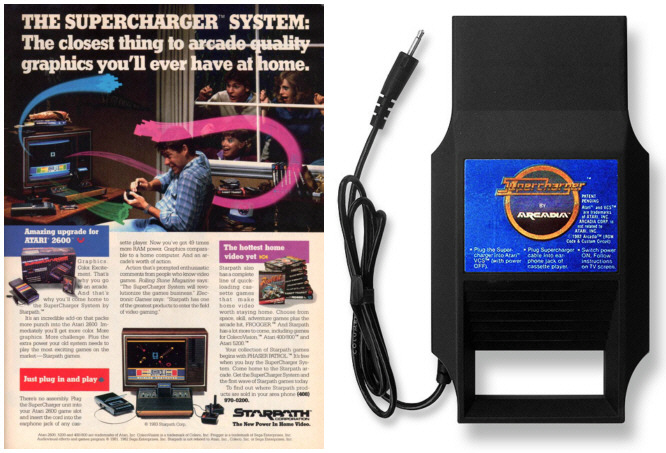
A magazine advertisement
for the Supercharger (left), Supercharger cartridge (right)
The added 6 KB of RAM gave the programmers the freedom to create games with more complex variables that in turn would allow for better graphics. The Supercharger doesn't add any graphical hardware but the added RAM allows for the game code to be larger so the console's performance is enhanced through software tricks. Having the ability to use cassettes also opened the door to another nifty trick, having multi-load games. With this ability, games could be of almost any size (12, 18, 24, etc. KB) as all that had to happen was to reach a certain point in the game and to then load the next portion. The programmers for the Supercharger did take advantage of this feature and the company released 5 of these games.
The Supercharger was designed to be compatible with the Atari VCS/2600, the Atari 2600 Jr., and the Sears Video Arcade. It did not work with the ColecoVision's Expansion Module 1 due to the shape of the Supercharger. Interestingly, Starpath sent owners of the Module 1 who contacted them extenders to let the Supercharger fit into the Module 1. Owners of early Atari 7800 consoles could also use the Supercharger but changes made to later versions of the console (to fix a compatibility issue with the 2600 version of Dark Chambers) rendered the Supercharger incompatible with the 7800.
As an interesting historical note, Arcadia Corporation had to change its name shortly after the Supercharger was released to Starpath Corporation. This change came to avoid litigation for trademark violations with Emerson Radio Corporation and their Arcadia 2001 console. The rebranding resulted in the initial batch of Superchargers to be released under the Arcadia Corporation name and later units having stickers on the box that clearly stated "Starpath Corporation (formerly Arcadia Corporation)" using the same logotype.
The Game Library
Starpath released a total of 12 games for the Supercharger. Ten of these games could be found commercially and two were only available through mail order. The last two games were sold after the company had filed for bankruptcy and were sent as just a tape in a simple plastic case with a very simple game manual. The games, in order of release, were:
- Phaser Patrol
- Communist Mutants from Space
- Fireball
- Suicide Mission
- Escape from the Mindmaster
- Dragonstomper
- Killer Satellites
- Rabbit Transit
- The Official Frogger
- Party Mix
- Sword of Saros
- Survival Island
While several of the games were original in nature, some were clones of existing arcade games (i.e., Killer Satellites was a take on Defender) and some borrowed elements from other arcade games (i.e., Rabbit Transit borrowed from Frogger and Q*bert).
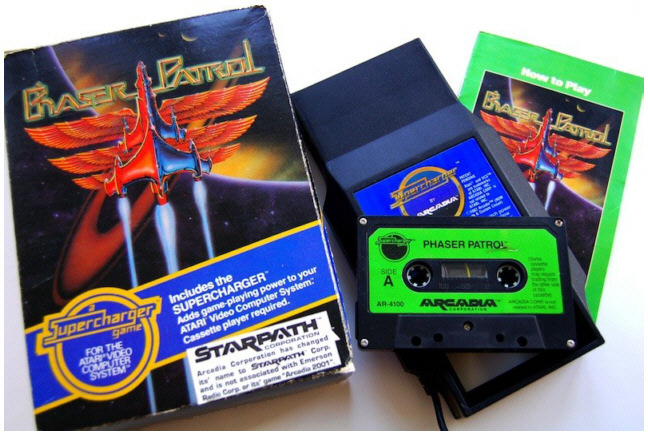
Phaser Patrol / Supercharger
retail packaging with sticker noting the name change from Arcadia to Starpath
Phaser Patrol was the pack-in game that came with the Supercharger itself. This game was Starpath's take on Star Raiders but with superior graphics and sound. It took advantage of the various buttons on the console for ship functions (i.e., you check the galaxy map by moving the "Left Difficulty" switch and activate shields with the "Color-B/W switch"). It also has a nice status display indicator and radar that is very useful. One of the coolest features is seeing the shields go up and down!
One of the most impressive games for the system was Escape from the Mindmaster. In this game the player is immersed in a world of 3D mazes played in first-person perspective. The game requires multiple loads as the player advances through the mazes and passes the "tests" of the Mindmaster.
Another title that is very impressive is The Official Frogger. Though the 2600 had had Frogger already released by Parker Brothers, Starpath was able to blow that version out of the water with the extra RAM in the Supercharger by securing the magnetic media license, which Parker Brothers didn't have. This version of The Official Frogger has multicolored sprites, animated characters, and music that plays throughout the game (and more than one tune, at that!). The only thing missing is a title screen.
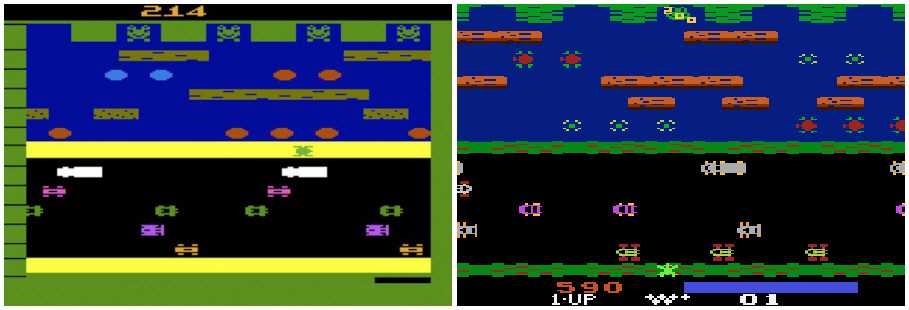
Frogger by Parker Brothers
for Atari 2600 (left), The Official Frogger by Starpath for Atari 2600
with the Supercharger's expanded memory (right)
Sadly, Starpath Corporation fell victim to the North American Video Game crash and this is why the Supercharger had such a limited number of games. Some game prototypes that have been found or released in some manner since the company merged with Epyx in 1984. Three of these titles were early versions of released games: Labyrinth, Meteroid, and Excalibur. Labyrinth was an early version of Escape from the Mindmaster, Meteroid was an early version of Suicide Mission (and was meant to be more accurate version of Atari's Asteroids), and Excalibur was an early version of Dragonstomper. A fourth prototype also exists for a game titled Sweat: The Decathlon Game, a game that was likely a take on Track & Field.
Reception and New Releases
The Supercharger was well received by gamers of the time. Its first released title, Phaser Patrol, received a Certificate of Merit in the category of "Best Video Game Audiovisual Effects" at the 4th Annual Arkie Awards. It is unfortunate that Starpath went bankrupt because it would have been interesting to see what else they could have done with this add-on.
Thankfully, the Supercharger still has its fans today and there have been new homebrew releases for it in recent years. Currently there are four such titles: KC Monster Maze, StarBlitz, Starfleet Simulation, and Warp Drive: Starfleet Simulation II. Who knows what else we might see released in the future?
How to Play Supercharger Games Today
Though you can certainly play Supercharger games with a compatible console and the original tapes, getting a complete collection can be cost prohibitive today. As of this writing, there are two collections being sold on eBay. These collections are complete (including the Supercharger, all the boxed releases, and the two unboxed games) and they are listed at $925.00 and $1,995.00!
Another alternative is to obtain the audio CD Stella Gets a New Brain released by Cyberpunks. There are two versions of this CD but they contain all the titles for the Supercharger. These are also not cheap to find and sell for about $400 on eBay.
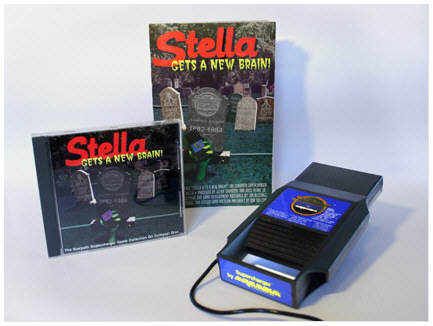
Stella Gets a New Brain,
a Supercharger compilation release
A more realistic alternative is to obtain the game ROMs (they have been converted into binary files), which can be used either with an emulator (such as Stella) or with a Harmony Cart. The former lets you play the games on your computer, while the latter lets you play on an Atari 2600 or compatible system.
And there is yet another alternative. The audio files of the games can be found in MP3 format and can be loaded into a working Supercharger using the headphone jack on any audio player. This will let you also experience the games on real hardware while avoiding the pitfalls of magnetic media.
Final Remarks
Though the capabilities of the Supercharger
were matched and even surpassed with special hardware additions to 2600
cartridges later on, the Supercharger still offers some unique games for
the 2600 that make it worth having. It certainly is the only way
to play the best version of Frogger ever made for the system. If
nothing else, be sure to check out its game library through emulation.
You will be certain to have fun.
|
Happy 20 Year Anniversary, Retrogaming Times!
Wow. This online magazine is officially retro itself! Truthfully, the longevity and success of this magazine is attributed to all of the passionate and gifted editors, readers, and writers out there that refuse to let their fire for retro games and electronics burn out.
On a personal level, Retrogaming Times changed my life in a very positive way. When my best friend Landon and I started The Retro Junkies podcast back in early 2012, we created a Facebook group page to talk with like-minded retro-maniacs. Well, one day, someone shared a link to the latest issue of Retrogaming Times Monthly (it was a monthly magazine back then), and I was really intrigued by the content and layout of the magazine. I only wish I could remember who sent the link and which issue I read first! Anyway, the biggest appeal for me back then was that it was a free magazine with fifteen-year legacy behind it - and anyone could contribute!
That's when I reached out to former Retrogaming Times Monthly editor Bryan Roppolo. All I can say about Bryan was that he was just as much of a class act then as he is now - and I'm proud to call him a friend. Anyway, it was just a few days before the 2012 Christmas issue (issue 103, I believe?) was to be published when I sent him an email, hoping to contribute to the long-esteemed magazine for the January 2013 issue. He immediately got back to me and said, "Why not write for the Christmas issue?"
It was that simple!
No writing samples. No resume. Just send what you can. That's what I loved about Retrogaming Times. The magazine was a labor of love written by retrogaming fans for retrogaming fans.
Then, I thought - what should I write about? And how should I write? Should I be an objective reviewer - completely detached from nostalgia? Or should I write with my own personal biases while proudly sporting my rose-tinted glasses? Honestly, I didn't know. However, I was always told to just write and keep writing until you stumble onto something. That's what I've always tried to do.
First, I wanted to pick a well-rounded game that I absolutely loved and grew up playing well into adulthood. Secondly, I wanted to pick a game that meant a lot to me on a personal level - a game that was the epitome of some of my brightest childhood days when my family was still together. The problem was, I was torn between two games that meant the world to me - TMNT III: The Manhattan Project and Batman - both for the NES. Therefore, I decided to pull an all-nighter a day before the submission deadline and write about them both!
Looking back at this particular TMNT 3 review, five years later, I realize that my writing style really hasn't changed a whole lot. I can't - no matter how hard I've tried over the years - write about a game I don't care about. For me, games are like photographs and memories from my childhood. I kept most of my games throughout the years, not just because I love playing them, but because I love the people who played them with me. I love the stories each one of these games carry with them - the memories are what it's all about.
And that's why I am still here with The Retrogaming Times. Through many trials and tribulations, Retrogaming Times is still moving forward stronger than ever. I owe this magazine a great deal of gratitude, because I have made countless memories and friends because of it. This magazine has a heartbeat. I could feel it five years ago, and I can still feel it today. Everyone part of it truly cares about the content and sense of community this magazine has created, and I am proud to be a small part of it.
Thank you, David, for keeping this wonderful magazine as strong as ever. And thank you, fellow readers and writers alike for all of your support and contributions to the legacy of Retrogaming Times.
Here's to another 20 years!
Cowabunga!
Rob "The Retro Junkie" Luther
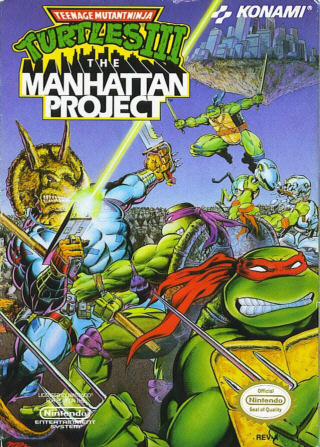
Teenage Mutant Ninja Turtles III: The Manhattan Project
July 1992. Amidst the smell of pizza, birthday cake, and freshly cut grass, four legendary heroes stood upon the ledge of the pool with Super Soakers in hand. There was Chris, the leader of the gang who was Gloucester City's little league baseball MVP. There was Eddie, the kid who was so funny and laid back that I often wondered if he ever had an awkward moment in his entire life. There was Kenny, the kid who would rather play with a Rubik's cube for 12 hours than talk to a girl for 12 seconds. And then there was me, the kid who would love to be the leader, the funny guy, or the genius - a kid who always tried to blend blue, orange, and purple only to find a pallet of puke green that left much to be desired!
After a front flip, back flip, screwdriver jump, and a cannonball, we heroes plunged into the pool with a certain grace that only second graders possessed. Then, much to our chagrin, we heard Eddie's mother shout from the back yard, "Eddie, it's time to open your presents!" We waited for Chris to give us his approval, leapt out of the pool, and ran for the porch.
Eddie eagerly opened his presents: Batman socks, an American Gladiators lunchbox and thermos, Ghostbusters play sets, and the Hungry Hungry Hippos board game - which I wanted to con Eddie into setting up as soon as we were away from the parental units. Then, as Eddie began tearing the wrapping off a small rectangular box, Chris, Kenny, and I froze in our tracks. There, before our very eyes, was the game we'd all been drooling over for literally months on end - Teenage Mutant Ninja Turtles III: The Manhattan Project for the Nintendo Entertainment System. I looked at my buddy Kenny with starry eyes and managed to scratch out a very faint "Cowabunga..."
Now, 20 years later, I can't help but smile when I think about those days in Eddie's attic kicking back in our beanbag chairs, chugging Slimer Hi-Cs, and saving Manhattan Island from the evil Shredder's clutches. However, I need to clarify one point before I continue. While this game is synonymous with my childhood, I didn't choose to review it for the simple sake of nostalgia. Teenage Mutant Ninja Turtles III: The Manhattan Project for the Nintendo Entertainment System is, without a doubt, the most underrated game in the Ninja Turtles series. To put it another way, it's totally bodacious, dudes!
The Radical Run-Down:
Publisher: Konami of America, Inc.
Developer: Konami Corporation
Released: February, 1992
Platform: NES
Genre: Action/Side-Scrolling
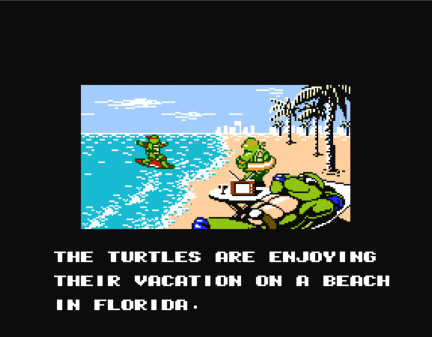
The Story in a Half-Shell:
Teenage Mutant Ninja Turtles III: The Manhattan Project begins with the turtles catching up on their green tans on a beach in Key West, Florida - with Leo rocking the shades like only Leo can - when suddenly, the four heroes get breaking news: Shredder has taken Manhattan Island hostage by suspending it hundreds of feet above the Hudson, Harlem, and East River! Oh, and Channel 6 news reporter April O'Neil has been kidnapped by the Shred-Head as well. ...Someone needs to keep an eye on that woman! Now, it is the turtlesí daunting task to defeat Shredder and his infamous Foot Clan, rescue April O'Neil, and save the citizens of Manhattan Island before sundown... Hey, it's all in a day's work, right?
The Gnarly Gameplay:
The gameplay is where Teenage Mutant Ninja Turtles III truly shines. Some critics argue that TMNT III is too much like its classic predecessor TMNT II: The Arcade Game, which was released two years earlier, but it's the subtle improvements in the third installment that make it a gem for the NES. For instance, now the turtles can flip enemies over their heads, which typically makes short work of the Foot Ninjas! Another improvement is the signature move that each turtle possesses. By pressing both the A and B buttons simultaneously, the turtle of your choosing will perform a special attack that will inflict significant damage on enemies. The catch, however, is that these special attacks deduct health points, so be sure to use the attacks wisely. TMNT III's graphics have also received a facelift! Vibrant shades of oceanic blue collide perfectly with the golden grains of sand, multi-colored Foot Ninjas seem to pop out of the TV screen, and, of course, the dark red shades of Manhattan provide an eerie backdrop as the turtles make their way to Shredder's Technodrome. Yet another notable improvement lies within the level designs. From the beach of Key West to the floating Island of Manhattan, each of the eight levels seem fresh and innovative - aside from the generic "Beach" signs from stage one, but I digress! Avid turtle fans won't be disappointed with the inclusion of memorable villains too! Fans can expect to see the following cartoon and toy line villains in 8-bit goodness: Dirtbag, Groundchuck, Slash, Leatherhead, Bebop, Rocksteady, Tokka, Rahzar, Krang, Shredder, and, yes, Super Shredder - Oh, how I loved Secret of the Ooze!
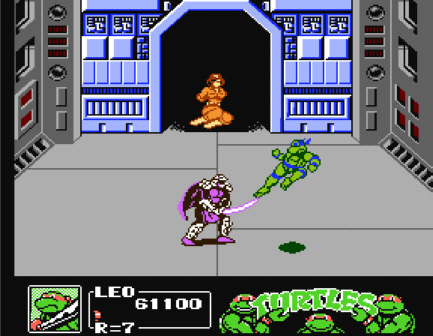
Sweet Soundtrack:
It's incredibly challenging not to mention the absolute BEST part of Teenage Mutant Ninja Turtles III - the music! During the late 80s and early 90s, Konami/Ultra was prolific at composing some of the most memorable game soundtracks of all time, and TMNT III is no exception! With famous Konami composers like Yuichi Sakakura (Top Gun: The Second Mission), Tomoya Tomita (Gradius, Contra Force and Castlevania: Dracula X), and Kozo Nakamura (Zen: Intergalactic Ninja and Castlevania: Legacy of Darkness), it's no wonder that this game's music stands head and shoulders above its predecessors on the NES! This game's soundtrack is the epitome of party-surfer music blended with splashes of tension at just the right times! Okay, folks. Confession time. To this very day, every time I see a beach, I can't help but whistle TMNT III's Stage One music. ...Is that sad?
The Retro Junkie's Famous Last Words:
In 1992, the Nintendo Entertainment System's life cycle was dwindling down - and, alas, the Turtle craze was fading too. With the Sega Genesis and Super Nintendo hitting their apex of popularity, gamers often forgot that the NES was still cranking out great games. It seems that TMNT III was lost in the shuffle between the popular 1989 TMNT Arcade Game and TMNT IV which was released in late 1992. Nonetheless, from the innovative gameplay, graphics, and level design, to the unbelievably memorable music, Teenage Mutant Ninja Turtles III: The Manhattan Project for the NES was and still is the complete beat-'em-up package wrapped in a green bow! Something needs to be said for a game that keeps me coming back for more 20 years and counting.
Overall, I give Teenage Mutant Ninja Turtles
III: The Manhattan Project for the NES: 9 Cowabungas out of 10!
|
The word legacy, to me, is something that endures through time, and is left for future generations to ponder, and hopefully appreciate as those that did prior. I am a proud retro gaming store business owner, and the word legacy often ties into those games that stick with you, past the box art, or the actual gaming experience itself. To me, retro games have a legacy that is strongly tied to one's personal nostalgic experiences that always appear whenever a certain game appears in one of our glass cases or shelves.
For me, whether it is as a store owner, a part time editor of this publication as I was at one time, or a contributing writer, which I was, and through the consistent encouraging (see: badgering) of one Rob Luther, I plan on being again, God willing, I am a protector of that legacy, and a storyteller of it, and it's a pretty cool gig. Few things excite me more than telling someone the history of a game, or educating a young person who wants to know about the games their parents or older siblings played when they were young. I've always believed that no dust sleeve, no clamshell case, and no well-built shelving unit, can truly maintain the legacy of classic games. It is up to those who know the stories and have those experiences to continue telling them, sharing them, and writing about them.
I got into Retrogaming Times simply because I was educated to be a writer. Four collegiate degrees and a ton of student loan debt later the sad truth is where I am from there is not many jobs for what I do, and the few that are will be held until death it seems, so as I was introduced to The Retro Junkies Network, Retrogaming Times Monthly became a well known thing to me, and I felt my awkward "kid shooting spitballs in the back of the class" (thanks Aaron!) approach to writing about retro games and personal experiences would be a nice fit, and it was.
I take on many projects and can be found many places because I want to keep that legacy alive in as many formats as I can. Running my store six days a week has made me realize one very important thing about that word, legacy. It truly is as good as what it is when you leave it, and when developers left these games to history, to time, they built things that I truly believe modern games cannot duplicate, and the legacy those games leave in the future just won't have the substance these games have.
I was told by a customer recently that modern games lack heart in comparison to the classics of days gone by, and I think it is because modern game developers are largely about making money first, and being indifferent to whether or not the game is a success, whereas it often felt like retro games, while obviously about making money as well, have this heart and drive where maybe not always, but more often than not, there's a feeling of "Man, I hope this game is a success, and the people playing it can feel the passion we put into it."
Passion, whether it be the video game industry
of yesteryear, the current gaming market, and those who so fiercely write
about it with passion, can often lead to creating a pretty awesome legacy.
|
While I didn't contribute to the original Retrogaming Times, I was a frequent reader, stumbling onto the newsletter around its third year in publication. I can still recall when I first read the final issue, number 80, in April of 2004. For whatever reason two things about that final issue of Retrogaming Times have remained distinctly planted in my mind. The first was Tom Zjaba's introduction leading off with, "And if you're using dialup, it may also take a bit to load" in regards to the extremely large multi-page issue that was ahead and the widespread variances in Internet connectivity of the time. The other was Doug Saxon, an early Retrogaming Times contributor, quoting Mr. Zjaba as saying something like, "Just wait, things will change" in regards to selling off or parting with large video game collections. Things certainly do change and things certainly have changed. Retrogaming as a whole has changed over the past twenty years, and changed quite a bit.
I also remember a blog post I made on a communal blog I co-hosted with a couple friends and co-workers about how strange it was to see Retrogaming Times winding down. I noted that while I may have not read every issue as soon as it came online, I would always check in regularly to catch up, reading long into the night on some occasions. In my mind Retrogaming Times was a fixture of the fansite age of the Web that began in the late 1990's. As affordable and easy to use computers became the rule in the home, rather than the exception, they were bolstered by a new generation of tools designed to grant the common person online access. This meant a whole wash of "regular people" using computers online and if that sounds like the present day, let me assure you it was quite different. There was a genuine spirit of wonderment and an emphasis on sharing common interests that surrounded the online culture of that time. I've always said that when someone first gets online they generally look up something they like rather than something they're angry about, and the turn of the previous Century was all about typing an interest into a search engine and finding people online who shared in it. During that era of anime fanpages and packed chat rooms, Retrogaming Times was always there and was a huge part of my time online.
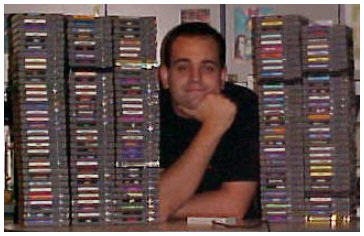
Myself, circa 2004, with
what was the beginning of my second NES collection
And now it was ending, after about seven years online Retrogaming Times drew to a close, with a huge issue and a massive celebration. It was a newsletter that wasn't just about the collecting aspect of retrogaming. It was just as much about playing the games, as retrogames didn't stop being fun just because they were old. As there was still more to play, more to say, and more to discover - the game didn't end with issue 80. Rather, a continuation newsletter, Retrogaming Times Monthly, was handed the torch and continued on. As had been the standard with Retrogaming Times, the call went out from Retrogaming Times Monthly senior staff for those interested in contributing to the newsletter to submit articles. In December of 2004 I did just that, and with issue seven of Retrogaming Times Monthly I began writing about the NES games that Tengen published, comparing them to their original arcade counterparts. I would contribute on a generally regular basis, on a number of different topics, until December of 2013 when I decided to take a hiatus for a short while. In early 2014 the entire newsletter decided to take one as well.
I make no bones about my lack of writing prowess, my style is simply amateur up and down and I know this. Yet that's why Retrogaming Times and Retrogaming Times Monthly appealed to me. Even if someone wasn't super detailed historically or didn't have a background in the written word, they still had real genuine interest behind what they were writing. If the newsletters didn't exist, everyone else would miss out on that viewpoint - on that personal story. In modern times things are almost the exact opposite, with many mainstream retrogaming pieces generally written by people with no passion for the hobby or no personal history with the subject matter. Regardless of anything else that may be said, the articles contained in the Retrogaming Times newsletters at least had passion behind them, and in my opinion that made each and every submission important. I missed writing for Retrogaming Times Monthly but I missed reading it even more. I missed the memories that reading about a game would bring to mind or being introduced to a game that I had never heard of before. More than anything I missed the outlet and opportunity for those stories to come up. That's why in late 2015 I got the ball rolling on a re-launch and by March of 2016 it was underway. My focus was to be really old school with the whole thing, to keep the newsletter approachable to all who may want to contribute, and easy to read and archive for those looking for specific information. Things had changed a lot in nineteen years, both in online content delivery and in gaming, but if I was going to publish a retrogaming newsletter it was going to be retro from the ground up.
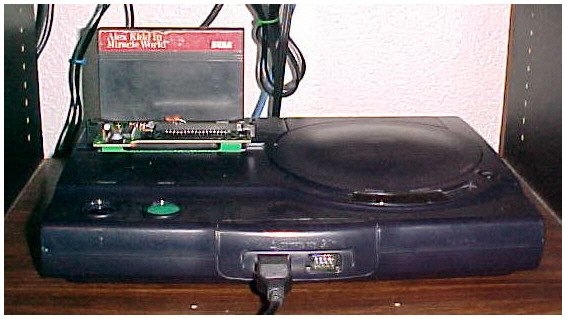
Yes, a Power Base Converter
works fine in a JVC X'Eye if you de-case it - the oddball things we used
to do to maximize hardware...
I think the biggest single difference between retrogaming when I first began reading Retrogaming Times and now, is the wide acceptance of alternate ways to play. There was a period when emulation was scoffed at and things like multicarts were very rare and in the hands of the very few, generally hand assembled in someone's garage, making legends out of people like Sean Kelly. If you weren't playing on "real hardware" then you weren't playing real games. This is understandable to a certain degree considering the state of emulation at the time, particularly in how limited the selection of console-accurate input devices were for playing games on a computer. There is something to be said for the experience of playing games on their native hardware, from display quirks to input method, however this seemed to be the biggest divide in the community as it was - and collecting games is what you did if you were serious about playing games.
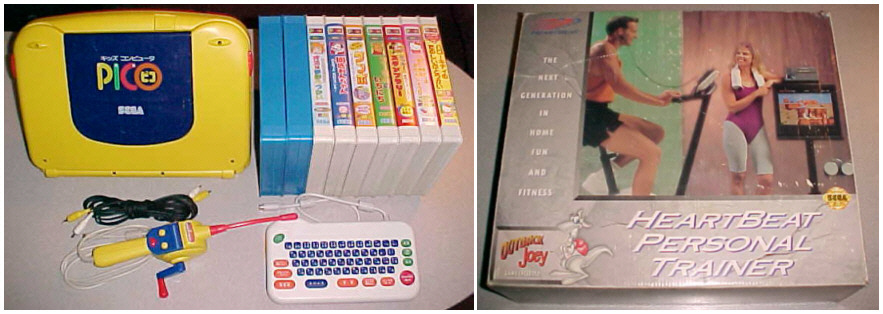
Two of my favorite flea
market finds from years ago, including a Japanese Sega Pico with fishing
and keyboard games (left),
and a boxed, complete,
unused HeartBeat Personal Trainer with Outback Joey (right) - don't ask,
I sold it long ago for way less than it would go for now
As time went on and the first decade of the 2000's ended, this notion seemed to do a complete 180 as some people began to build massive collections, by any means necessary, to fill out shelf space rather than game time. This in part helped to drive the secondary price up on games and hardware as a whole, which in turn only made the hobby more desirable to those previously outside of it, because if there's one thing that makes the world go 'round it's money. Retrogames started to be looked at by some as an investment, rather than entertainment, and regardless of your view on the matter you can't deny that prices increased across the board due to this. Now if you wanted to play original games on actual hardware you had a few core options. You could be fortunate to have a local store that sold at affordable prices, you could be lucky to still find games out "in the wild" at places like flea markets and yard sales at uninflated values, or you could shell out top dollar online or with dealers that based their prices on the absolute highest comparative online selling price - handily looked up on their smartphone. Stores like FuncoLand were gone and the days of going into a national retail chain and walking out with a bag of NES games for $25 were over. If you wanted to play older games and explore system libraries, the better option was rapidly becoming emulation but that didn't do much for a collection.
Now the above examples aren't everyone, I want to make that totally clear. Gaming is something different to everybody and that's one of the reasons why it's such a great thing. However no one will ever be able to convince me that this shift in the mainstream didn't occur. It's the whole reason why it's now so easy to use classic game controllers on modern computers, with a host of controller adapters that let you use the genuine article while playing games via emulation. The birth of high quality flash memory cartridges allow emulation and original hardware to join together, making it so everyone can enjoy rare or expensive games as they were designed to be played, on actual original hardware. This also massively opened up homebrew game development on consoles and gave fan translation projects a much-deserved showcase in the gaming mainstream. I can honestly say that I have played through more fan-translated games in the past three years than I ever have previously, and I've been playing fan-translated games since the late 1990's. A Turbo EverDrive (flash memory cartridge for the TurboGrafx-16 / PC Engine) has been "the" single greatest edition to my gaming hardware setup in the past decade, as it allows me to stretch that entire amazing library of games for all they're worth - without stripping me of all that I am worth. It also opens the door for playing PC Engine fan translations on real hardware, including a translation of the PC Engine release of The Tower of Druaga, created by Retrogaming Times Monthly alumni and former editor Scott Jacobi. Amazing how things like that come back full circle.
Retrogaming has become an industry, its own separate industry apart from video gaming as a whole. While I know some people get sore about this, and yes there are a number of fly-by-night companies that have defrauded and attempted to take advantage of this industry, at the end of the day it means more controllers in more retrogamer's hands. Isn't that what everyone who has ever designed a video game really wanted most in the end - people to actually play them?
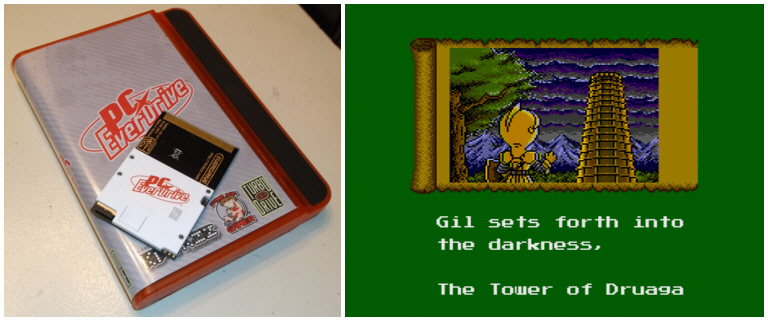
PC Engine flavor Turbo
EverDrive (left), Scott Jacobi's PC Engine Tower of Druaga fan translation
(right)
Video gaming should be more about inclusion rather than exclusion, variety rather than structure. Games are meant to be entertainment, and entertainment should be something enjoyed by all. The modern era of availability and choice allows that, more so now than ever before. Yeah, I miss coming home from the flea market every week with load upon load of cheap cartridges and hardware but it's not like I play fewer games now. My interest hasn't waned, the delivery method has just changed a little. The true legacy, in my mind, of retrogaming at the current moment is the ability to play nearly any classic video game you can think of, right now - in a number of different ways on a number of different devices. These old games were mainstream in their heyday and they're mainstream now. That's pretty freaking cool when you step back and think about it.
Games that were old when Retrogaming Times
began in 1997 were still fun. Now in 2017 there are a lot more old
games and guess what - they're still fun and they're still waiting to be
discovered. No one has played everything - well, maybe except Mr.
Arcade from those old Coleco VFD arcade tabletop commercials if you believe
the ad copy. It has been over half a century since engineers first
played electronic tennis on an oscilloscope, creating the beginnings of
recreational video games. For one-third of that time a "Retrogaming
Times" newsletter has been in publication. If that's not a legacy
worth celebrating, then I don't know what is.
|
For the twenty-first consecutive year, arcade game and pinball collectors and enthusiasts came together in Silicon Valley for the insane exposition known as California Extreme. For this special weekend a group of arcade hobbyists, collectors and vendors haul their arcade cabinets and pinball machines to a convention location and make them available for the public to play. It's not just local collectors either as many exhibitors move their machines cross country, and in some cases globally, simply to allow the public to enjoy them. A modest entry fee gets you in for the entire weekend (Saturday 11am to 2am Sunday morning, and then on Sunday from 11am to 9pm) and all games contained within the show are there to be played and are free to play outside of the entry fee. California Extreme also hosts a full complement of panels featuring industry reunions, trivia competitions, film screenings, gameplay and maintenance tutorials, new game announcements and more. There are multiple tournaments held throughout the weekend including professional pinball competitions, an old school Street Fighter II Hyper Fighting tournament that has become a show staple in recent years, and lots more. There are also many merchandise vendors that both exhibit games and sell products, as well as a console gaming section upstairs with even more vendors, local groups, and even more games to play. Live music was also featured this year on Saturday evening, presented in partnership with Rockage: San Jose who also hosts a local retrogaming and music festival. Once again California Extreme was hosted at the fabulous Hyatt Regency, Santa Clara. Unlike the previous years at this amazing venue, an entire additional ballroom was added to the main show floor, allowing for more space to move around and obviously even more games to play.
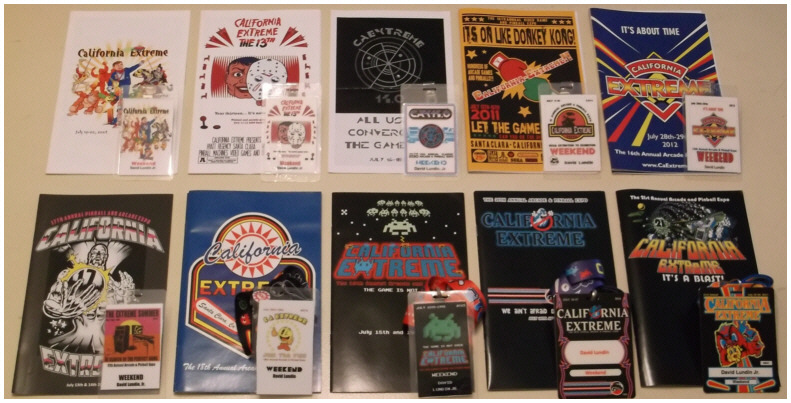
Ten years of CAX programs
and badges from their 12th show to their 21st (2008 - 2017)
This year marked my tenth consecutive show in attendance. I've make sure to attend California Extreme every year since moving back to Silicon Valley and it is easily one of the events I look forward to most every year. If you can think of a classic arcade game, you can probably find it at California Extreme, including an assortment of the rare, the never mass produced, and the one-of-a-kind. As I've covered nearly every year of my attendance in the issues of The Retrogaming Times and Retrogaming Times Monthly, I thought I would again focus on a few of my favorite games from the show. When it comes to the show as a whole, it's really best to attend and experience it in person. If you have never been and arcade games and pinball interest you to the smallest degree, then you should check it out. If you're local to the Bay Area then that goes double.
Well, okay, two of these games were featured in last year's show report but I simply cannot get enough of either so here they are again! Nichibutsu's Crazy Climber from 1980 shows how a unique idea can lead to an amazing game. Featuring the simple premise of a regular guy climbing up a series of skyscrapers by hand, the game soars (or is that climbs) due to its extremely intuitive control system. A pair of identical joysticks correspond to the climber's hands, one for the left and one for the right. Moving them alternately up and down will get the climber into a brisk rhythm as he scales the building from window to window. Additionally they can be used to move the climber to the left or right, pull himself up one level at a time with a single hand, or hang on to a ledge to keep from falling off if struck by an obstacle. Yes, it seems everything in the world is trying to keep the climber from reaching the helicopter that is circling overhead. Windows will slam closed and knock him off the building, residents will drop objects on his head, birds will bomb him with excrement and eggs, parts of the building itself will detach and cascade down, giant apes will attempt to punch the climber to the ground, sparking neon signs pose an electrocution hazard, and of course the varied structures of the buildings themselves must be negotiated. This is one that is a ton of fun and really can only be played properly on an actual cabinet.
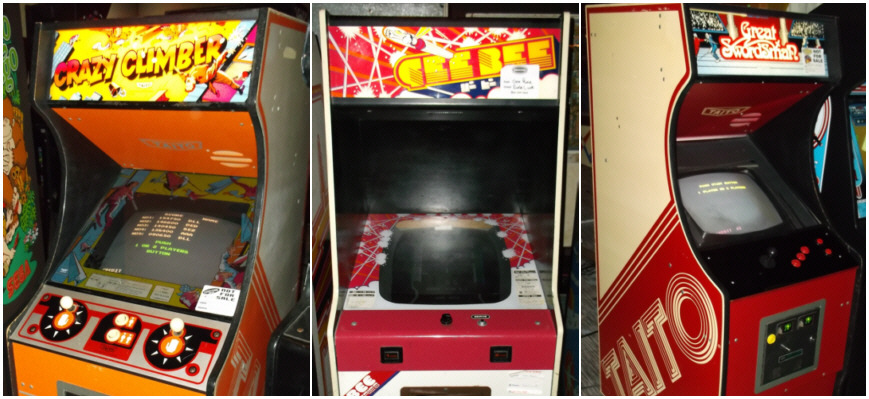
Nichibutsu's Crazy Climber
(left), Namco's Gee Bee (center), Taito's Great Swordsman (right)
Gee Bee is a rather important release from 1978 that tends to get overlooked and has become hard to find. This is essentially where the video gaming powerhouse of Namco really began, as it was the first arcade game they developed internally. It plays like a combination of Atari's Breakout and Video Pinball, combining a pinball-like playfield with blocks that must be knocked out with a ball. A spinner controls the in-game paddles used to direct the ball, with the objective to keep it in play and eliminate the targets. The monitor in the machine at California Extreme seemed to be having some slight hold issues, perhaps due to power sensitivity at the show, which meant that the black and white graphics were out of alignment with the color overlay. Still, it was a lot of fun to play and was a silently important game that I'm sure many overlooked at the show. Namco would later follow it up with two sequels, Bomb Bee and Cutie Q.
Of course I have to champion Taito's Great Swordsman, from 1984, once again. Next to the gentleman who built the cabinet and makes sure it gets to the show every year, I think I'm the game's biggest fan in the West. I know everyone is tired of hearing me talk about the game (it's featured as the icon that closes out every issue) so we'll keep it brief. A single player sword fighting game based around three disciplines: sport fencing, kendo, and gladiatorial combat, Great Swordsman is more about nuance and strategy than it is about fast action and button mashing. As with real sword combat, the idea is to get your opponent to open himself up for a strike. I love that this game was next to Data East's Karate Champ, also from 1984, as they really are the two arcade titles that are the most alike. Control utilizes a left / right joystick and three buttons used to control sword position: low, middle or high. The duration of button press along with joystick motion will cause the player to perform different lunges, strikes or parries. Techniques and strategies change depending on the sword fighting discipline as well as the opponent you are facing. While I failed to clear the fourth kendo stage this year, I had the high score both Saturday and Sunday of the show and as with last year, the game looked to be very popular for such an unknown title.
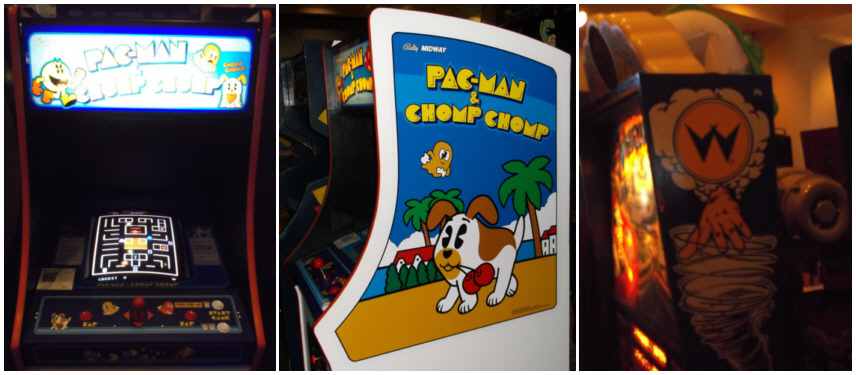
Pac-Man & Chomp Chomp
custom game and cabinet (left, center), Whirlwind fitted with a blower
rather than a stock fan (right)
In addition to the games you remember, you'll often also see custom games or modifications to your favorites out on the show floor. One of these that premiered a couple years ago is Pac-Man & Chomp Chomp, a re-creation of an unreleased localized version of Namco's Pac & Pal. Rather than the Pal character being a one-off for the game, it is replaced with Chomp Chomp, the Pac-Family's dog from the Hanna-Barbera Pac-Man cartoon. This version of the game seems to work better original, although aside from Chomp Chomp replacing Pal it plays the same. The most impressive part of the game however is the custom artwork on the cabinet, and "custom" is the key word here because the entire machine is covered with original art in the spirit of what it may have looked like had the game been released. The reprogramming, artwork, and cabinet construction were all produced by one of the youngest exhibitors at California Extreme, and his work is top-notch. Another of his creations is Crazy Otto, a re-creation of the game that eventually became Ms. Pac-Man, including a full custom art package. The attention to detail in these games is superb and although they are customs, they really have the look and feel of games that never were, sort of an alternate reality "if they ever produced them, this is what they'd look like." For the full story on these amazing games and to order custom artwork for your own project, check out the creator's site at pacificarcades.com.
Then there are specific games I look forward to playing at California Extreme every year. Whirlwind is probably my favorite of all the pinball machines that Williams produced but one Whilrwind at CAX is Whirlwind with a difference. The stock game has a small fan contained in the topper above the back box, which spins and blows air during certain game events. Well this special Whirlwind machine at California Extreme has the fan replaced by a high-powered blower, giving the gentle breeze of the original an eye-watering replacement. Truth be told, this is how the game should have shipped as the blower modified version really makes you feel as if you're in the middle of a tornado, fighting to keep your eyes open, and adds a lot to an already fantastic game. It's also just the game to play if you need to cool off at the show.
When it comes to things you can only see at California Extreme, I hope no show attendees missed The Predators, an unreleased four-player game from Williams. The boards for this game have been in collector hands for a while but the game itself was missing the interface used to link the four player stations to one another. This was eventually reverse-engineered, restoring full functionality to the game. Originally the full setup would have occupied four full size arcade cabinets, which may in part be one of the reasons it never entered production. A custom cabinet was designed by the owner to utilize modern display technology to have the game fit in the smallest configuration possible while still allowing comfortable play for four people. The artwork is all based on what it may have looked like, using as much of the original documentation as possible. The game itself is a lot of fun. If you've ever played the reasonably classic online multiplayer shooter Subspace, then you'll feel right at home with The Predators. In fact if I could describe it to anyone that's what I would say, it's like a classic arcade version of a four-player local game of Subspace.

The Predators custom
realization (left), The Irritating Maze (center), myself as Taizo Hori
/ Dig Dug in front of the game that made him a star
Based on a segment from a Japanese television show (Ucchannanchan no Honou no Challenger: Kore ga Dekitara 100 Man En!!) that required contestants to maneuver a rod through a giant electrified wire maze filled with gimmicks, The Irritating Maze is a hard to find game unlike pretty much anything else. A large trackball controls the direction and speed of the rod, represented in the center of the screen from the first-person perspective. If the rod touches the wire walls of the maze or any objects contained within, the player is zapped - translated into the real world by a high power blast of air across the control panel and up into the player's face. That doesn't sound like much but it is very startling, even when one is expecting it, due to the tension that builds while navigating the increasingly complex and demanding mazes. This is yet another game where the dedicated arcade cabinet is the only way to play, although two sequels were released to home consoles - a Japan-only Nintendo 64 sequel and a third game on the original PlayStation, which was localized for North America and released as Irritating Stick.
As with last year, I decided to make an appearance as Taizo Hori, better known to those in the West as Dig Dug, to commemorate the 35th anniversary of his original game. Originally created in 2014 as my first proper foray into cosplaying, along with my wife (then girlfriend) as Taizo's ex-wife Masuyo Tobi (star of the 1985 arcade game Baraduke, predating Samus Aran by a year), my suit is based on an interpretation of Taizo's design from the 2005 strategy RPG Namco X Capcom. I basically used the Namco X Capcom design as a base and attempted to incorporate callbacks to the history of the character, both from the Dig Dug and Mr. Driller games, and shoot for a more real-world representation of the character. I've worn it to a couple anime conventions and it always gets good response. I had worn it last year for the 20th anniversary of CAX but didn't spend too much time suited up. This year I spent about four hours on Saturday morning of the show playing games, talking to vendors, and walking the show floor. At the moment the picture of me at the machine was taken, both the game and myself are the same age. Yeah, I decided to start cosplaying in my early 30's. Before anyone asks, yes I do have a drill but didn't take it to CAX. I built a full-size replica of his Namco X Capcom drill, which incorporates pretty much every weapon he's ever had on any game (cleverly branded "P3" to follow in line with the "P" on his pump in the original game and drill in the Mr. Driller titles, complete with a few feet of detachable air hose and harpoon. However I'm really protective of it and it's reasonably fragile so I don't take it out a whole lot.

Densha de Go! bubble
marquee, over three and a half feet long!
I always buy a few things from the vendors at the show every year, whether some arcade marquees or a console game or some other assorted collectible. This year was no different but one item stands out. Among an assortment of pinball playfields and backglasses I spotted a Densha de Go! bubble marquee. Densha de Go! is a series of Japanese arcade games based around railroad operations, generally focused on operating commuter trains. Developed by Taito, the series began in the late 1990's and although it has been wound down a couple times in the past, it continues to be revived due to its popularity in Japan. Home versions of the game, complete with downsized versions of the unique arcade control panels, have been released to many platforms. Being a railroad enthusiast all my life, I love the Densha de Go! games, having gone so far as to cosplay as a Japanese salaryman from the Densha de Go! 2 commercials complete with a super-deformed E3 Series bullet train around my mid section, with my wife as series mascot Tetsu-chan. If you look the game up on YouTube chances are you'll also find a video of me giving a very rough crash-course on how to play the games for non-Japanese speakers. Needless to say, there was no way I could pass up the opportunity to obtain this sign. There's a small crack in the upper right edge on the side, but it can't really be seen anywhere from the top and I patched it with some plastic adhesive to keep it from growing. My plan is to convert it into a wall light, complete with the crossing lights flashing alternately. The whole thing cleaned up really nicely and looks great.
I can't imagine the undertaking that a show like this must entail, especially as it expands each year and only becomes bigger and better. What I find most awesome about California Extreme is that as much as the show has grown in the past ten years, it's still about bringing a bunch of games together in one location and sharing in the enjoyment of playing them with others. For one weekend a year the golden era of arcade culture is preserved there, in aspect perhaps - but with care and love and respect. Hundreds upon hundreds of games stand at attention each morning the show opens, awaiting the droves of attendees who come out every year to play them. As always, a tremendously huge thanks to the Extreme Team, exhibitors, volunteers and everyone else who comes together to host this show every year!
More information about California Extreme
can be found at http://www.caextreme.org
|
Every Friday on The Retrogaming Times Facebook page (facebook.com/theretrogamingtimes), we present a Weekly Retrogaming Trivia question. This just-for-fun trivia challenge provided each week is an opportunity to test your arcane and oddball retrogaming knowledge. The answer to the question from the previous week is posted along with a new trivia question every Friday!
Below is the recap of all questions and
answers posted between this issue and the previous issue:
06/30/2017 - WEEK 21
Question: In Metal Slug
3, what are the names of the four giant eels found underwater during Mission
1?
07/07/2017 - WEEK 22
Question: What is the
only first party US released Sega Saturn controller to feature true arcade
microswitches?
07/14/2017 - WEEK 23
Question: What does
entering "HELP ME" as your name in Castlevania III: Dracula's Curse grant
the player?
07/21/2017 - WEEK 24
Question: What game
was not only the last baseball game to be released on the Famicom but also
Namco's last game on the hardware?
07/28/2017 - WEEK 25
Question: Vehicles from
what other two Yu Suzuki directed Sega arcade games make cameos in After
Burner II?
08/04/2017 - WEEK 26
Question: What was the
first commercially sold pinball machine to feature speech?
08/11/2017 - WEEK 27
Question: It's in the
way that you use it: The title of id Software's seminal first-person shooter,
Doom, was taken from a line in what feature film?
08/18/2017 - WEEK 28
Question: Double or
nothing: In the film The Color of Money, what arcade game does Vincent
Lauria (Tom Cruise) claim is going to be his doorway into the United States
Military Academy at West Point?

Underwater depths in
Metal Slug 3 (left), Namco bids the Famicom era farewell (right)
Answers:
Week 21 Answer: Helen, Linda, Jenny,
and Barbie.
Week 22 Answer: The Saturn Arcade
Racer Steering Wheel, the butterfly shift paddles are microswitched
Week 23 Answer: Ten lives rather
than the standard three.
Week 24 Answer: Famista '94, part
of the very long running Family Stadium series.
Week 25 Answer: Hang-On (motorcycle)
and OutRun (Ferrari), in the form of an escort during takeoff after the
runway resupply intermissions.
Week 26 Answer: Gorgar by Williams,
in 1979.
Week 27 Answer: The Color of Money
(1986), "Doom" is what Vincent Lauria (Tom Cruise) says he has inside his
pool cue case.
Week 28 Answer: Stocker, by Bally
Sente (1984), "Ten years from now, a guy who scores heavy on Stocker is
a shoe-in at The Point."

OutRunning an F-14 (left),
Tom Cruise playing Stocker in The Color of Money (right)
Don't be left out! Be sure to follow The Retrogaming Times on Facebook for a new retrogaming trivia question every Friday!
We need your questions! If
you have a trivia question you would like to submit for possible inclusion
in the Weekly Retrogaming Trivia question pool, e-mail it to trt@classicplastic.net!
If you question is selected to be featured, you will be entered in our
year-end prize drawing!
|
In closing out this issue I want to express a tremendous thank you to the twenty years that both writing staff and readers have given to the idea of a newsletter like this. The notion that hobbyists and enthusiasts can come together for no gains other than the simple commonality of shared interest. Let's be honest, time is the most valuable asset to any of us, even if we don't always realize it. The time spent in writing, researching, publishing, hosting, promoting, and ultimately (but no less importantly) reading these newsletters has obviously had a positive and lasting impact on a lot of people. So here, twenty years later, I can say to Tom Zjaba - you gave back an immeasurable amount to the retrogaming community with Retrogaming Times. We want to continue to give back to the retrogaming community, which is why this newsletter continues.
Something I do want to mention that Donald Lee talked a bit about is an archive of the past twenty years of newsletter content. At present I am working on a single unified archive directory that will feature every issue of every newsletter that was part of the Retrogaming Times family. These will be presented as PDF files as that seems to be the easiest way to ensure archival stability for the future. I've been working on this here and there throughout 2017 and I'm currently finishing up the last couple issues that had problems, which were preventing them from being cleanly archived. Back issues of The Retrogaming Times will continue to be hosted as plain .html but will also have PDF counterparts in the legacy archive. I'm hoping to have this online by the end of 2017 but there is always a chance it may slip forward into 2018. It won't go online until it is 100% completed but do keep in mind that it is coming. When it does go live it will be announced on The Retrogaming Times homepage as well as on Facebook.
I do want to end, just this once, on something that Tom Zjaba would close out most issues of Retrogaming Times with. That would be a brief list of the music he was listening to while building the issue. Generally while editing articles and assembling an issue I listen to the online radio station CD101.9 Smooth Jazz New York, (www.smoothjazzcd1019.com) as I've always found that type of music easy to do writing work against. However this time around I was also listening to the DanceDanceRevolution 5thMIX and DDRMAX DanceDanceRevolution 6thMIX soundtracks (old school South Bay DDR freestyler for life) as well as quite a bit of Dire Straits.
Thank you once again for reading The Retrogaming Times. We'll be back on November 1st with our next issue. Be sure to follow The Retrogaming Times on Facebook and join our new community! I sincerely hope you enjoyed this issue and that you will return to read the next issue and possibly submit an article yourself. Remember, this newsletter can only exist with your help. Simply send your articles directly to me at trt@classicplastic.net or check out the submission guidelines on the main page. Submit an article today and join a great retrogaming tradition!
See You Next Game!
 |

Content and opinions on this
page are those of their respective writer(s)
Assembled and published
by David Lundin, Jr. on September 1st, 2017 at ClassicPlastic.net
© 2017 The Retrogaming
Times. All Related Copyrights and Trademarks Are Acknowledged.